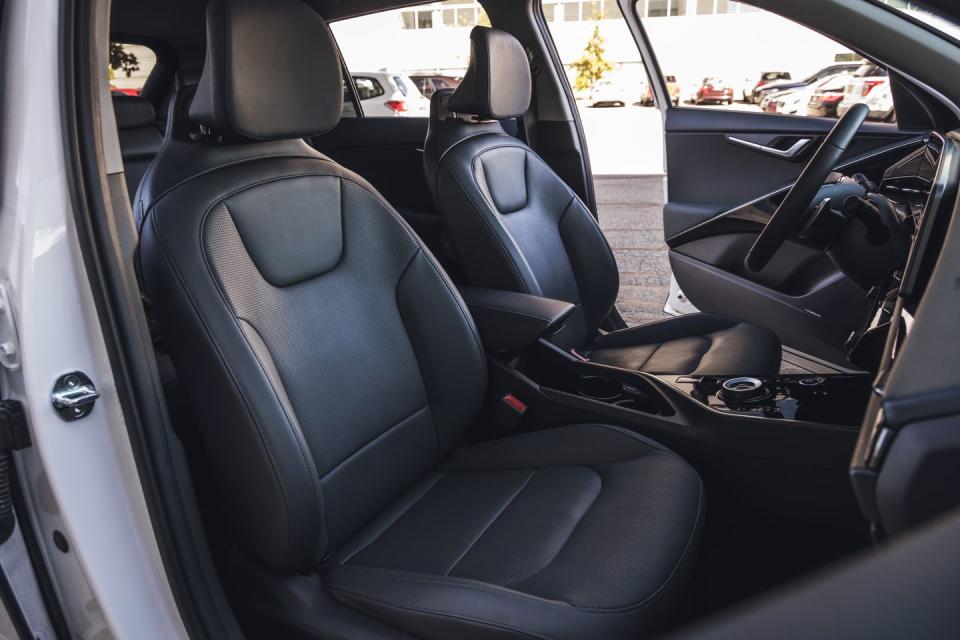2023 Kia Niro Hybrid and Plug-In Hybrid: Two Hybrid Hearts Beat as One

Kia's second-generation Niro marks more than just a redesign for the small SUV; it rethinks the model's powertrain hierarchy. Although it continues to offer hybrid, plug-in hybrid, and electric variants, the 2023 Niro now clearly positions their importance by performance.
The Niro EV remains the performance leader of the bunch courtesy of its 201-hp front-mounted electric motor. This remains the case for the 2023 Niro, as the battery-electric model carries over the same powertrain as before. The two gasoline-electric options, however, no longer share the same horsepower rating. Whereas the standard Niro hybrid’s 104-hp 1.6-liter four-cylinder engine and 43-hp electric motor together produce a peak output of 139 horsepower, the pricier Niro plug-in hybrid (PHEV) now makes a total of 180 horsepower courtesy of its more powerful 83-hp motor. In addition to the ability to drive some distance on battery-electric power alone, the PHEV also delivers additional performance.
The PHEV Powers Ahead
Although our testing showed that neither the Niro hybrid nor the Niro PHEV accelerates with exceptional fervor, the PHEV offers enough grunt for merging onto freeways or passing at highway speeds with relative ease. Its 7.3-second run to 60 mph and 5.0-second sprint from 50 to 70 mph are perfectly adequate.
The Niro hybrid hit the same marks in a much more languid 8.9 and 6.2 seconds, respectively. Unlike the PHEV, overtaking slower-moving traffic in the Niro hybrid requires careful planning. Boot the accelerator, and the little four-cylinder engine strains to reach its 6000-rpm redline.
Hybrid's Fuel Economy Falters
So limited is the hybrid's output, its six-speed dual-clutch automatic gearbox often holds fifth gear at highway speeds. This trait likely played a part in the Niro hybrid's 39-mpg result in on our 75-mph fuel-economy test, which fell 6 mpg short of the EPA's highway estimate. It's also 7 mpg worse than we saw with the last Niro hybrid.

Even so, the Niro hybrid bettered the 37-mpg highway figure its PHEV counterpart managed (in its hybrid mode). The PHEV's 249 pounds of extra mass surely was a factor—a portion of that is due to the PHEV's larger lithium-ion battery pack. In its EV mode, the Niro PHEV was able to do 25 miles, which is a bit shy of its official 33-mile range estimate but does improve upon the 18 miles we squeezed out of the outgoing PHEV's battery pack.
City Slickers
The PHEV's extra pounds exacted a minor toll on its handling and braking performance. Fit with the same 18-inch Continental ProContact RX all-season rubber as its hybrid sibling, the plug-in Niro pulled 0.85 g around our 300-foot skidpad and came to a halt from 70 mph in 171 feet. Meanwhile, the Niro hybrid circled our skidpad at 0.87 g and stopped from 70 mph in 168 feet, the latter of which equaled the stop we measured in a Hyundai Kona N on summer tires.

Admittedly, neither the Niro hybrid nor PHEV is particularly exciting to drive. Kia attempts to will some athleticism into both Niros by way of a Sport drive mode, but engaging this setting seems to do little more than improve accelerator response ever so slightly, make the steering heavier, and afford manual control of the six-speed gearbox via the paddle shifters. Stick to the default Eco mode and the right pedal lethargically reacts to inputs, the steering effort feels more natural, and the steering-wheel-mounted paddles function as tools for adjusting the level of regenerative braking. No matter the drive mode, the long-travel brake pedal of both Niros predictably and progressively blends the vehicles' regenerative and mechanical braking functions.
Both gasoline-electric Niro models feel more attuned to urban settings. Credit the 125 and 150 pound-feet of torque produced from the respective electric drive motors of the hybrid and PHEV that help these Kias deliver reasonably brisk low-speed acceleration.
Their cabins also are calmer at urban driving speeds, in contrast to the din suffered on the highway. The hybrid is particularly noisy and registered 73 decibels at 70 mph. That's 3 decibels more than the PHEV and 5 decibels more than its forebear.
Inside the Niro
Little differentiates the two Niros inside. Unlike our early-build example, the production hybrid will have a T-handle shifter while the PHEV gets a rotary-style setup. Both these pre-production cars had a 10.3-inch instrument-cluster screen, but the production version instead will have a smaller 4.3-inch info display that's bookended by digital gauges. (Kia reserves the full-digital single-element display for the Niro EV.)
Despite casting a 2.5-inch-longer shadow and sitting on a 0.8-inch-longer wheelbase than its predecessor, the Niro held the same number of carry-on-size suitcases as its predecessor: six with all seats in use and 18 with the rear seatbacks folded. (The Niro hybrid offers additional under-floor space compared to the PHEV, which uses this area to house its bigger battery.) Rear-seat legroom, though, has improved by more than two inches relative to the prior Niro.

With a starting price of $27,785, the 2023 Niro hybrid undercuts the base PHEV by $7250. The PHEV, however, skips the hybrid's entry-level LX trim, instead starting off in EX guise. Looking EX to EX, the PHEV's premium falls to $4590. Considering the PHEV pairs ample electric-only driving range with greater power and acceleration, it justifies its upcharge over its more sluggish hybrid sibling.
You Might Also Like

